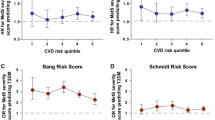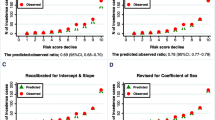Abstract
Traditional risk charts for the prediction of cardiovascular disease (CVD) include cholesterol parameters. We evaluated how models predict fatal CVD when cholesterol is replaced by glucose parameters. We used data from NHANES III, a US survey conducted 1988–1994 (follow-up until 2006); 15,454 participants (1,716 CVD deaths) were included. Based on the ESC SCORE method, we used age, sex, blood pressure, smoking and either of the following: (1) total cholesterol, (2) total-to-HDL-cholesterol, (3) glucose, (4) glycated hemoglobin (A1C). Scaled Brier score (BS), Nagelkerke’s R2 (NR) and integrated discrimination improvement (IDI) were used for model comparison. The ranking (best to worst) was: A1C (BS = 11.62 %; NR = 0.0865; IDI = 0.0091), glucose (11.16 %; 0.0734; 0.0067), total-to-HDL-cholesterol (9.97 %; 0.0547; 0.0010), cholesterol (9.75 %; 0.0484; 0, reference). Differences between models with cholesterol and glucose or A1C were statistically significant. This study suggests the use of A1C instead of cholesterol parameters in charts to assess CVD risk.


Similar content being viewed by others
Abbreviations
- CVD:
-
Cardiovascular disease
- A1C:
-
Glycated hemoglobin
- NHANES:
-
National Health and Nutrition Examination Survey
References
Conroy RM, Pyorala K, Fitzgerald AP, et al. Estimation of ten-year risk of fatal cardiovascular disease in Europe: the SCORE project. Eur Heart J. 2003;24(11):987–1003.
Assmann G, Cullen P, Schulte H. Simple scoring scheme for calculating the risk of acute coronary events based on the 10-year follow-up of the prospective cardiovascular munster (PROCAM) study. Circulation. 2002;105(3):310–5.
D’Agostino RB Sr, Grundy S, Sullivan LM, Wilson P. Validation of the framingham coronary heart disease prediction scores: results of a multiple ethnic groups investigation. JAMA. 2001;286(2):180–7.
Faeh D, Braun J, Bopp M. Body mass index vs cholesterol in cardiovascular disease risk prediction models. Arch Intern Med. 2012;172(22):1766–8.
Selvin E, Steffes MW, Zhu H, et al. Glycated hemoglobin, diabetes, and cardiovascular risk in nondiabetic adults. N Engl J Med. 2010;362(9):800–11.
National Center for Health Statistics. Plan and operation of the Third National Health and Nutrition Examination Survey, 1988–94. Series 1: programs and collection procedures. Vital Health Stat 1. 1994(32):1–407.
Royston P, Explained variation for survival models. Stata J (2006) 2006; 6(1):83–96.
Steyerberg EW, Vickers AJ, Cook NR, et al. Assessing the performance of prediction models: a framework for traditional and novel measures. Epidemiology. 2010;21(1):128–38.
Gneiting T, Raftery AE. Strictly proper scoring rules, prediction and estimation. J Am Stat Assoc. 2007;102:359–78.
Nishimura R, Nakagami T, Sone H, Ohashi Y, Tajima N. Relationship between hemoglobin A1c and cardiovascular disease in mild-to-moderate hypercholesterolemic Japanese individuals: subanalysis of a large-scale randomized controlled trial. Cardiovasc Diabetol. 2011;10:58.
Orchard TJ, Temprosa M, Goldberg R, et al. The effect of metformin and intensive lifestyle intervention on the metabolic syndrome: the diabetes prevention program randomized trial. Ann Intern Med. 2005;142(8):611–9.
Iqbal N, Rubenstein AH. Does lowering of blood glucose improve cardiovascular morbidity and mortality? Clin J Am Soc Nephrol. 2008;3(1):163–7.
Acknowledgments
This work was supported by the Swiss National Science Foundation (grants 3347CO-108806, 33CS30-134273, 32473B-125710, 32473B-143897).
Conflict of interest
The authors declare that they have no conflict of interest.
Author information
Authors and Affiliations
Corresponding author
Electronic supplementary material
Below is the link to the electronic supplementary material.
Rights and permissions
About this article
Cite this article
Faeh, D., Rohrmann, S. & Braun, J. Better risk assessment with glycated hemoglobin instead of cholesterol in CVD risk prediction charts. Eur J Epidemiol 28, 551–555 (2013). https://doi.org/10.1007/s10654-013-9827-6
Received:
Accepted:
Published:
Issue Date:
DOI: https://doi.org/10.1007/s10654-013-9827-6




